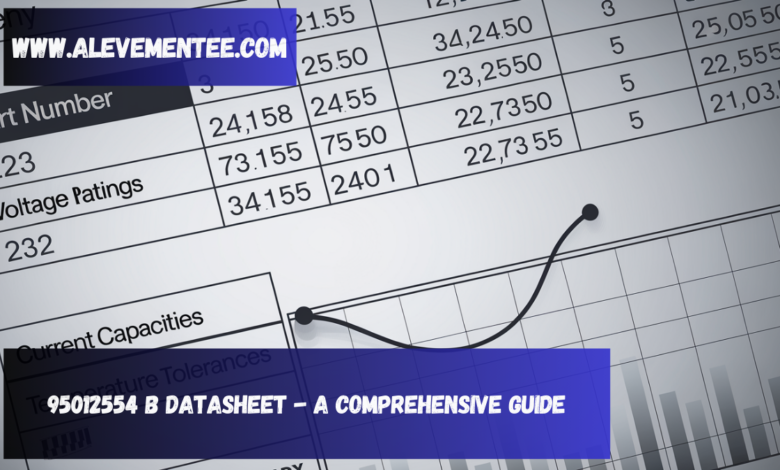95012554 B Datasheet – A Comprehensive Guide

The 95012554 B datasheet is an essential technical document that provides crucial specifications and details about an electrical or electronic component. For those involved in engineering, manufacturing, or even hobbyist projects in the USA, understanding a datasheet is key to ensuring the safe and effective use of any component.
The 95012554 B datasheet provides essential information about voltage ratings, current capacities, and temperature tolerances, ensuring safe and effective use in various electronic and industrial applications.
In this guide, we’ll explore the specifics of the 95012554 B datasheet, break down the technical details, and explain the importance of these specifications in simple, easy-to-understand terms.
What is the 95012554 B Datasheet?
The 95012554 B datasheet serves as the go-to document for anyone who needs to understand the critical features of the component it describes. Typically, it includes a wealth of information, such as:
- Voltage ratings
- Current capacities
- Temperature tolerances
- Pin configurations
- Package types
- Mechanical dimensions
Each of these aspects is crucial to ensure the component works properly in your circuit or system. In this article, we’ll cover each section of the datasheet and explain its significance, especially if you’re new to reading datasheets or dealing with technical documents.
Why Datasheets Matter
Datasheets are critical in helping engineers, technicians, and product designers select the right component for their application. They help you avoid overloading a component, using it in the wrong environment, or failing to provide the necessary conditions for it to operate safely and efficiently.
For example, if you exceed the current rating listed in the 95012554 B datasheet, the component could overheat and fail, potentially damaging your entire circuit. The datasheet provides all the information needed to avoid such issues and to design reliable and safe systems.
Key Elements of the 95012554 B Datasheet
Now, let’s break down the most critical sections of the 95012554 B datasheet:
1. Voltage Ratings
The voltage rating in a datasheet is one of the most important specifications. It tells you the maximum voltage that can be applied to the component without risking damage or failure. Exceeding this rating could result in permanent damage.
In the case of the 95012554 B, the voltage rating is typically designed to withstand standard operating conditions for both low and high-voltage applications. Always ensure your system operates below this threshold to maintain performance and safety.
2. Current Capacities
The current capacity specifies how much current the component can handle without overheating. This is crucial for designing circuits that do not draw too much power, especially if you’re dealing with high-energy systems.
In the 95012554 B datasheet, the current capacity will be clearly defined. It’s essential to select a component that can handle the expected current in your circuit, or else it might overheat or even fail.
3. Temperature Tolerances
Temperature ratings are critical for determining the environmental conditions in which the component can safely operate. The 95012554 B is designed to function within specific temperature ranges, both in terms of minimum and maximum tolerances.
This section of the datasheet is especially important for outdoor or industrial applications where extreme temperatures are common.
4. Pin Configuration and Functionality
Understanding the pin configuration is essential for ensuring the component is connected correctly in a circuit. This section of the 95012554 B datasheet provides detailed information on each pin’s function, whether it’s power, ground, or signal input/output.
5. Mechanical Dimensions
The mechanical dimensions section provides a detailed layout of the component’s physical size and shape. This is particularly important if you’re designing printed circuit boards (PCBs) or other housing for your electronics.
Common Applications of the 95012554 B Component
The 95012554 B component can be used in a wide variety of applications, such as:
- Consumer Electronics: Used in devices such as smartphones, tablets, or computers.
- Industrial Automation: Implemented in machinery to ensure stable operation under different loads.
- Automotive Systems: Found in sensors, control units, or infotainment systems within vehicles.
- Telecommunications: Critical in the infrastructure of mobile networks and data centers.
Each application requires a deep understanding of the datasheet to ensure the component performs effectively in the intended environment.
Interpreting Technical Terms in the 95012554 B Datasheet
If you’re new to datasheets, here’s a quick guide to some technical terms you may encounter in the 95012554 B datasheet:
- Max Voltage: The highest voltage the component can safely handle.
- Continuous Current: The maximum current the component can carry continuously without overheating.
- Power Dissipation: How much power is lost as heat during operation.
- Thermal Resistance: Measures the component’s ability to dissipate heat, crucial for cooling systems.
Understanding these terms will help you better interpret the datasheet and make informed decisions about using the 95012554 B component.
FAQs
1. What is the maximum voltage rating in the 95012554 B datasheet?
The maximum voltage rating ensures that the component can safely handle up to a certain voltage without damage. Always refer to the specific datasheet for this figure.
2. Why is current capacity important in a datasheet?
Current capacity is crucial because it tells you how much electrical current the component can handle without overheating or becoming damaged.
3. Can the 95012554 B component be used in extreme temperatures?
Yes, but only within the specified temperature range indicated in the datasheet. Exceeding these limits could result in malfunction or failure.
4. How do I know if a component fits on my PCB?
Check the mechanical dimensions section of the datasheet to verify the physical size and layout of the component.




